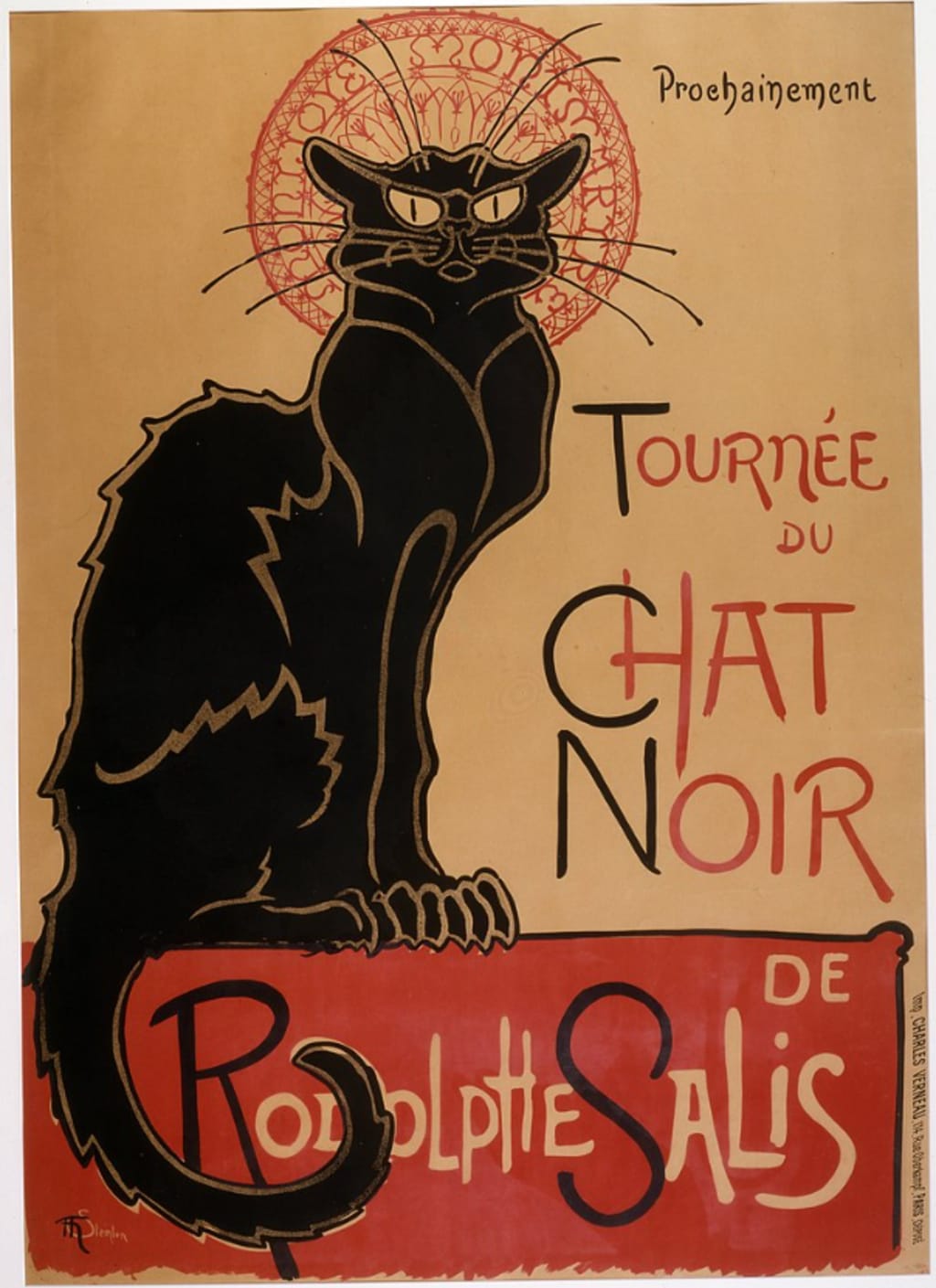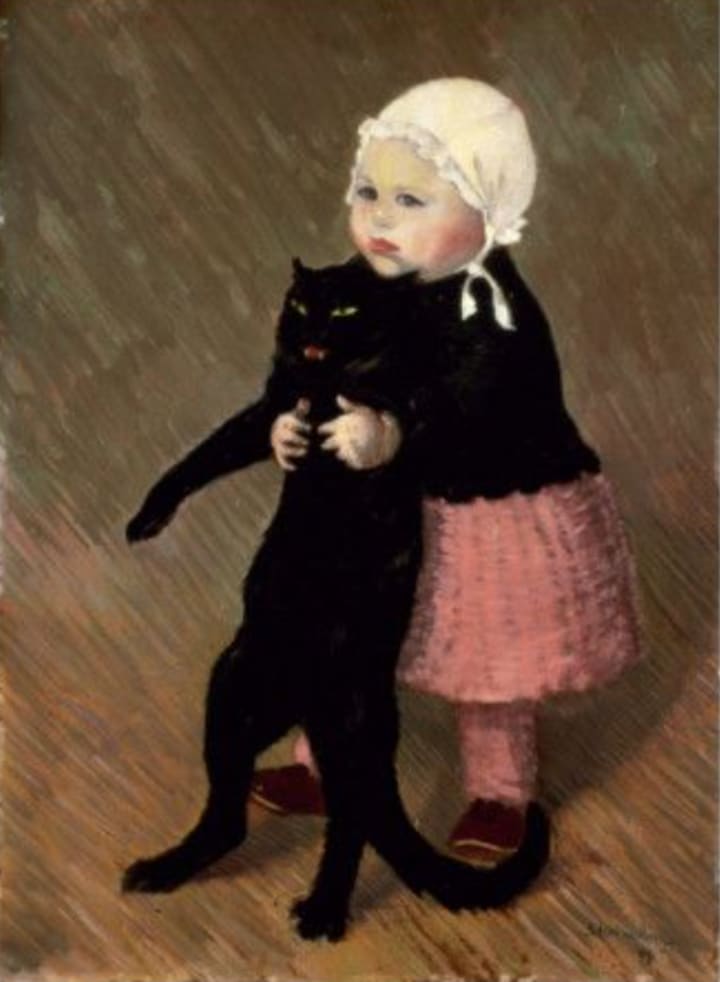The Great Cat
And his very good friend

“Théo, mon ami, when you said you had need of me to finish a most inspiring piece, I came running, non?”
There was a grunt behind the easel followed by the sound of furious brushstrokes.
“I had to dodge horses and donkeys and the feet of the people outside. So much so I nearly did not see the dogs. That blasted pack that parades up and down Rue Tourlaque. Pah! But I was clever, see. I lost them when I climbed the trees…”
“Hush, Simon. I am trying to concentrate.”
“Please - do not let me distract you. So, I climbed the trees, the hounds barking and baying oh so fierce and I thought, Simon, this is it, the Lord has marked you and has sent his dreadful servant to collect. And no one would appear before poor Théo in his hour of need and - aie!”
There was a sigh and a man leaned over to peer from behind the easel. “Colette, my dear, please be gentle with my friend.”
To which a high and piping voice replied, “oui, Papa,” and a small hand proceeded to flatten the fur along Simon’s back.
“Easy, easy!” Simon tried to slink away from the girl but she followed his every move. He groaned when she tugged him closer to her body. “Truly, this can’t be what you meant when you said you needed inspiration. We’re famous after all!”
“There is something I wish to capture and both you and Colette are a part of it.” Simon watched as Théo ducked back behind his easel. “It will be a masterpiece, I just know it.”
“So you say.” Simon squinted as Colette pulled his ears behind his head.
“You doubt me, old friend?”
“Non, mais, you must agree that this sitting is much different from the one I did for your last masterpiece.”
“And yet it still couldn’t keep Le Chat Noir from closing its doors!”
Simon heard the anger in Théo’s brush and winced. “Come now. The cabaret was Salis and Salis the cabaret. When he passed - may God have mercy on his soul - it was almost expected that he would take his work with him. Tragic, but expected.”
“I will create something that will endure,” he heard Théo grumble, “no matter what happens or how long it takes!” Then, to Simon’s dismay he tore a sheet of oil paper from his board and tossed it aside.
“Surely there was something salvageable there,” Simon protested, but all Théo’ said was, “try to hold that pose." He proceeded to swish his brush in a small, tin cup. The sharp smell of turpentine stung Simon’s nose and he sneezed. Colette chortled above him and wiped his face with her little hands. That made Simon sneeze even more.
“You know, Théo,” he said after Théo’s brushstrokes became less harsh and more focused. “If you’re having trouble, why not take your work outside? That new tower is complete, after all.”
Théo grumbled under his breath, but Simon heard every word. “How Eiffel managed to get the world to love that skeletal husk is beyond me.”
“You never know what you like until you paint it,” Simon purred. “Paint me lounging atop of it and it would make what we did with Le Chat Noir look like child’s play.”
Simon perked up as Théo dropped his brush into the tin can. He watched as the man leaned over to peer at him. “Hmmm…”
Simon leapt to his feet.
“Believe me, mon ami!” he said with relish. “Forget the successes of the past and look to the glory of your future! Your name and mine shall be known far and wide and - mrrooww!”
Colette cried out with glee. “Papa! Look how tall Monsieur Simon is!”
The girl had toddled up behind Simon and now held him close to her body, her arms circled around his chest. Simon struggled and turned wide, golden eyes up at Théo.
“Save me!” he cried. His hind legs danced to keep his balance while the girl swayed and giggled. “Théo, please!”
But Théo’s thoughtful expression had brightened and, with a sinking heart, Simon watched him tear down his board and grab the nearest canvas.
“That’s it!” he exclaimed. “Colette, hold him. Simon, stop struggling - ”
“Théo!” Simon whined. He kicked out as Colette giggled and held him closer. “I thought we were friends!”
“We are, mon ami! And this will be remembered!”

*
*
*
Théophile Alexandre Steinlen (1859-1923) was the Swiss-born French painter known for his love for cats. Among his most famous works was the iconic poster he painted for Rodolphe Salis’ cabaret, Le Chat Noir (1896), which closed down after Rodolphe’s death in 1897 (before reopening 10 years later). Théophile and his wife, Emile, had one daughter named Colette. A Small Girl With a Cat (1889) is believed to be a full length portrait of Colette as a toddler.
*
*
*
Thank you for lingering.
Reader insights
Outstanding
Excellent work. Looking forward to reading more!
Top insights
Expert insights and opinions
Arguments were carefully researched and presented
Excellent storytelling
Original narrative & well developed characters
Heartfelt and relatable
The story invoked strong personal emotions
Compelling and original writing
Creative use of language & vocab
Eye opening
Niche topic & fresh perspectives
Easy to read and follow
Well-structured & engaging content
On-point and relevant
Writing reflected the title & theme







Comments (32)
Love your stories so much ❤️❤️ Let's engage with each other's content 💪💪💪
Very nice! https://vocal.media/journal/what-global-issues-we-are-facing-today
Cats always make stories better. Quite an enjoyable read.
This may be one of my favorite stories ever! I love it.💙Anneliese
very interesting piece
Nice Work!!!
I love this! So well done! Simon's voice rang true and spoke with the painting. Congratulations on your win! ❤️❤️❤️
Awesome! That is cute and historical. Thanks Loryne! I learn something new everyday! I read the cat's voice in an American imitation of the French accent as is typical in movies such as Disney and Pixar that have French characters. It reminds me of a story somebody made a while back for the outer space challenge where the alien inspired the famous painting of "The Scream." I need to find that person again and leave them a nice comment or two. Congrats on placing in the tall tale challenge. Way to weave some history into Your fiction. This is a nice story to linger on and the way You constructed the dialogue leaves me thinking that I need to step up my game.
Congratulations Loryne! Alas, I am far removed from toddlerhood, but I still play the "look how tall you are!" game with my dogs, so I really chuckled at that bit. 😂 And when Simon says "please, don't let me distract you" and promptly continues prattling. Hilarious!
Congratulation!!! Such an amazing tale from the mind of Loryne! I thoroughly enjoyed it.
Oh wow, that was so cool. I was beginning to wonder if this was going to be inspired by real works. So, THAT'S the true story behind it all. Really love how you created that whole situation, the world, the voices of the characters, so unique! Bravo! Oh, and congrats on placing in the contest! Well deserved!
Congrats Loryne!! 😁
Of course you placed! This is the literal definition of Art History or rather History Art. It brings real meaning to breathing life into a work of art. Congratulations!
Wow! This is fabulous! Very clever. And well a deserved place! Congratulations!
I can not believe I missed this. It is wonderful and I really like the note at the end. Congratulations
well - you created great voices here... I am glad you were recognized for this piece.
Yay! Loryne!!! Congratulations 🎉🎈🐈⬛
Fabulous!!! Congratulations!!!💖💖💕
Congratulations!! This was great!
Congrats! Such a gem of a story.
Congratulations! Well deserved.
Great story concept! Merci!
Absolutely charming story!! 😍😍 Those french accents were divine. Really loved the idea of a story paired with a famous picture. Well done! ❤️
I absolutely love this! ❤
Tres bon ami, 😀 well written and moved along tres bon ❤️